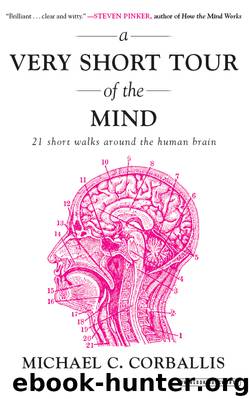A Very Short Tour of the Mind by Michael Corballis

Author:Michael Corballis [CORBALLIS, MICHAEL C.]
Language: eng
Format: epub
Tags: SCI019000
ISBN: 9781468315462
Publisher: The Overlook Press
Published: 2013-06-25T16:00:00+00:00
12
Music
Music has been the neglected child of the sciences of the mind. Charles Darwin wrote: ‘As neither the enjoyment nor the capacity of producing musical notes are faculties of the least use to man … they must be ranked among the most mysterious with which he is endowed.’ Steven Pinker declared that musical cognition was not worth studying as it was merely ‘auditory cheesecake’, a by-product of language.
Certainly, language and music have much in common. Both consist of complex sequences of unlimited variety. Just as there is no limit to the number of different sentences we can produce or understand, so music provides us with a seemingly endless variety of tunes and compositions. Both require precise timing, and both are predominantly based on sound, with a substantial element of bodily movement as well. Language can be accomplished by gesture alone, as in sign languages, and most of us gesture as we speak. Similarly, music gets the body moving through association with dance, or rhythmic tapping.
In many ways, too, language and music are intertwined. The most obvious example is song, where the melodic accompaniment may help to convey emotion. It may also serve a mnemonic function. It is easier to remember words sung to a tune than to remember them as simple sequences, and songs are widely exploited in teaching language to young children. Poetry may also have the rhythmic quality of music, and again may have evolved to help our preliterate ancestors remember stories and pass them on to the following generations. Ordinary speech itself has a melodic component, known as prosody. The rise and fall of the voice can signal emotion, or differentiate statements from questions or commands.
Many languages, known as tonal languages, use different tones to distinguish between words themselves. In Mandarin Chinese, for example, there are five different tonal contours, so the word approximately rendered as ‘ma’ can mean five different things. Thus the sentence ‘Mama ma ma de ma ma?’, given the right intonation, can be taken to mean ‘Is mother scolding the horse’s hemp?’—not an everyday utterance, to be sure, but it makes the point. The language of the Pirahã, the small Amazon community in Brazil, is also tonal, and the people there can communicate quite effectively simply by whistling or humming.
Can you name any note played on the piano without looking at it? If you can, you have what is known as absolute pitch. This ability is more common in musicians, especially if trained from an early age, and is more easily taught to five-year-olds than to adults. It is fairly rare in our culture, but common in speakers of tonal languages. This raises the possibility that speech arose from music, an idea developed by the archaeologist Steven Mithen in his book The Singing Neanderthals.
The languages with the earliest roots are those of sub-Saharan Africa, and nearly all of these are tonal. A language consisting purely of tones would not have the precision of modern speech, but the addition of supplementary sounds, including click
Download
This site does not store any files on its server. We only index and link to content provided by other sites. Please contact the content providers to delete copyright contents if any and email us, we'll remove relevant links or contents immediately.
| Anatomy | Animals |
| Bacteriology | Biochemistry |
| Bioelectricity | Bioinformatics |
| Biology | Biophysics |
| Biotechnology | Botany |
| Ecology | Genetics |
| Paleontology | Plants |
| Taxonomic Classification | Zoology |
Sapiens: A Brief History of Humankind by Yuval Noah Harari(14252)
The Tidewater Tales by John Barth(12608)
Mastermind: How to Think Like Sherlock Holmes by Maria Konnikova(7227)
Do No Harm Stories of Life, Death and Brain Surgery by Henry Marsh(6891)
The Thirst by Nesbo Jo(6826)
Why We Sleep: Unlocking the Power of Sleep and Dreams by Matthew Walker(6618)
Life 3.0: Being Human in the Age of Artificial Intelligence by Tegmark Max(5474)
Sapiens by Yuval Noah Harari(5294)
The Longevity Diet by Valter Longo(5019)
The Body: A Guide for Occupants by Bill Bryson(4974)
The Rules Do Not Apply by Ariel Levy(4861)
The Immortal Life of Henrietta Lacks by Rebecca Skloot(4525)
Animal Frequency by Melissa Alvarez(4395)
Why We Sleep by Matthew Walker(4360)
The Hacking of the American Mind by Robert H. Lustig(4318)
Yoga Anatomy by Kaminoff Leslie(4306)
All Creatures Great and Small by James Herriot(4232)
Double Down (Diary of a Wimpy Kid Book 11) by Jeff Kinney(4207)
Barron's AP Biology by Goldberg M.S. Deborah T(4097)
